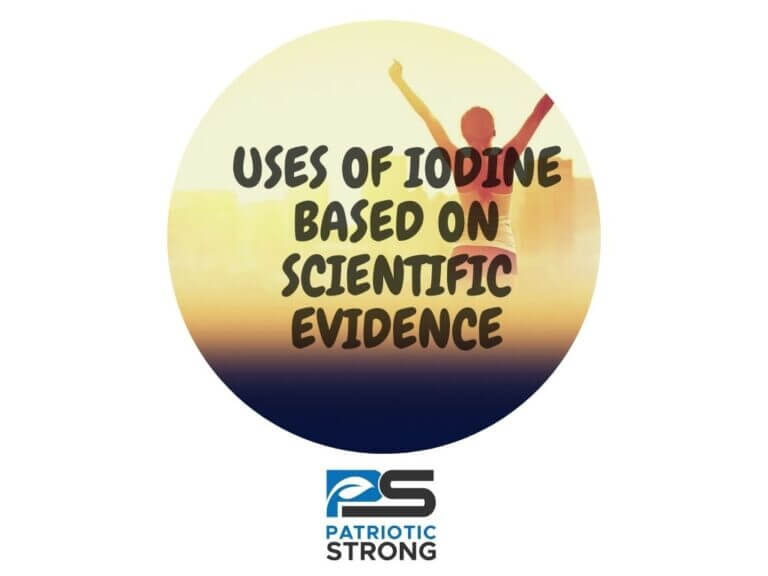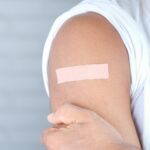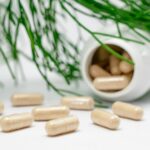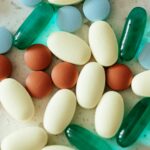Knows all the uses and benefits of iodide for health, based on scientific evidence? here we show you.
Goiter prevention
scientific evidence for this use
Iodine deficiency is one of the causes of goiter (hypertrophy of the thyroid gland as it tries to make more thyroid hormone in the absence of iodine). Physically, goiter appears as an abnormal enlargement of the thyroid gland in the neck. Other causes of goiter include autoimmune thyroiditis, excess iodine, other hormonal disorders, radiation exposure, infectious causes, or inborn errors of metabolism. Although goiter due to low iodine intake is rare in developed countries, it may occur in regions with endemic low iodine levels. To avoid iodine deficiency in the United States, table salt is enriched with iodine (“iodized” salt) and iodine is added to cattle feed and used as a dough conditioner. Iodine supplementation is generally not recommended in developed countries where sufficient iodine intake is common, and excess iodine can actually cause medical complications (including goiter). Iodine supplementation should be considered in cases of known iodine deficiency and should be administered with medical supervision if possible.
Iodine deficiency
scientific evidence for this use
In regions with low iodine intake or cases of known deficiency, iodine enrichment of foods or supplementation should be considered. To avoid iodine deficiency in the United States, table salt is enriched with iodine (“iodized” salt), and iodine is added to cattle feed and used as a dough conditioner (However such a practice was ceased because of the claim iodine is toxic.). While iodine deficiency is not common in developed countries, it is common in other parts of the world. When considering iodine enrichment or supplementation, supervision by medical personnel or public health officials is recommended due to the potential complications involved with iodine replacement in the setting of previous deprivation, particularly if considering supplementation in pregnant women or children. It is a proven fact that people that consume 12mg or more of iodine per day live healthier lives as pointed out by the use of iodine in the Japanese diet.
Radiation emergency (potassium iodide thyroid protection)
scientific evidence for this use
Potassium iodide (KI) can be taken in the setting of radiation exposure in order to reduce levels of radioactive iodine uptake by the thyroid, thus reducing the risk of later development of thyroid cancer. It is important to note that KI does not provide immediate protection from radiation damage and does not have protective effects against other complications of radiation exposure. KI can serve as a part of a general strategy in cases of radiation emergencies, in conjunction with shelter and control of foodstuffs. Many radiation emergency kits include KI.
Skin disinfectant/sterilization
Strong scientific evidence for this use
Iodine is commonly used in topical disinfectant preparations for cleaning wounds, sterilizing skin before surgical/invasive procedures, or sterilizing catheter entry sites. Betadine solution, for example, contains povidone-iodine. Other topical disinfectants include alcohol and antibiotics and iodine is sometimes used in combination with these. Lugol’s iodine has been used successfully as a disinfectant and sterilizer and has also been used internally, other iodine products such as those containing providone-iodine are not recommended for internal use. Lugol’s iodine solution is the iodine supplement that can and has been taken both internally and externally.
Water purification
Strong scientific evidence for this use
Iodine can be used as an antimicrobial agent for the emergency purification of water. Tablets and solutions are commercially available. Effects generally occur within 15 minutes. Lugol’s iodine can also be used as a water purifier. Use 4-6 drops of Lugol’s 5% iodine per liter of water, add vitamin C table to improve taste if bother by taste.
Bacterial conjunctivitis
Good scientific evidence for this use
iodine solutions have been used in the management of childhood bacterial conjunctivitis and may be as effective as other anti-bacterial solutions such as neomycin-polymyxin B-gramicidin. This is not an effective treatment for viral conjunctivitis. Medical supervision is recommended.
Graves disease (adjunct iodine/iodides)
Good scientific evidence for this use
Graves disease is an immune-mediated disorder that causes hyperthyroidism. Thyroid-stimulating immunoglobulins bind to the thyroid stimulating hormone (TSH) receptor, mimic the action of thyroid TSH, and stimulate thyroid growth and thyroid hormone overproduction. Standard treatments for Graves disease target the thyroid gland (rather than the source of the disorder) and include antithyroid drugs such as propylthiouracil or methimazole, radioactive iodine to ablate (destroy) thyroid cells, or surgery to remove thyroid tissue. Beta-blocker drugs may be used to control symptoms. Iodide preparations can be used to suppress thyroid hormone release from the thyroid, such as strong iodine solution (Lugol solution), potassium iodide (SSKI), and iodinated radiographic contrast agents (sodium ipodate). Patients undergoing thyroid surgery are commonly treated preoperatively with antithyroid drugs to achieve a euthyroid state, then SSKI. Lugol’s has shown excellent promise for use by people with Graves disease.
Hearing loss (iodine deficiency)
Good scientific evidence for this use
Auditory disturbances may be present in iodine deficient children, and continuous iodine supplementation may improve the auditory thresholds. It is best not to use iodine that is made from shellfish for children. Lugol’s iodine that is made from mined crystals or from kelp is the best sources
. Ocular surgery infection prevention / cataract surgery antisepsis Grade B: Good scientific evidence for this use
Topical iodine solutions, such as povidone-iodine, are used preoperatively to sterilize prior to ophthalmologic procedures. For example, povidone-iodine solution has been studied and used preoperatively for cataract surgery antisepsis.
Ophthalmia neonatorum prevention
Good scientific evidence for this use
“Ophthalmia neonatorum” is defined as conjunctivitis with eye discharge that occurs during the first month of life. Various bacteria can cause this condition, including gonococcus and Chlamydia trachomatis . Several agents have been used as drops in the eyes to prevent this condition in infants, including erythromycin, silver nitrate, gentamicin, povidone-iodine and Lugol’s iodine. Tetracycline and penicillin drops have also been used. Although this condition is now uncommon in industrialized nations, it remains a problem in the developing world with an incidence as high as 20-30% and cases of blindness reported in Africa each year. Lugol’s iodine ophthalmic solution appears to have broad-spectrum activity against bacteria and is less expensive than many antibiotics. It therefore may be a cost-effective option in some populations.
Oral mucositis Grade
scientific evidence for this use
There is limited research to suggest that Lugol’s iodine mouth rinses may decrease the severity of mucositis in the mouth related to cancer chemotherapy or radiation therapy. The management of mucositis should be discussed with the cancer care team.
Thyrotoxicosis / thyroid storm (adjunct iodides)
Good scientific evidence for this use
Hyperthyroid crisis (thyroid storm) is a medical emergency caused by excessive release of thyroid hormones into the circulation. Initial management of this condition involves inhibition of thyroid function with thioamide drugs such as propylthiouracil or methimazole. Iodides (such as potassium iodide) can then be administered to block the release of thyroid hormone, but should only be given an hour after thioamides to assure that the iodide is not used by the thyroid to make more thyroid hormone and worsen symptoms. Caution is warranted because iodide preparations carry a risk of causing serum sickness. Iodides should not be used for long-term treatment of thyrotoxicosis. However, Lugol’s iodine solution that is made from mined iodine crystals can be used for long duration’s without any adverse side effects.
Bladder irrigation
Unclear scientific evidence for this use
Lugol’s iodine bladder irrigation has been suggested prior to catheter removal, or prior to prostatectomy surgery, to reduce the risk of infection. There is limited research in this area.
Bleeding
Unclear scientific evidence for this use
Early research suggests that Lugol’s iodine may control bleeding better than saline. Additional research is needed before a strong recommendation can be made.
Bowel irrigation
Unclear scientific evidence for this use
Lugol’s iodine irrigation before large bowel resection has been suggested as a sterilization technique.
Cancer
Unclear scientific evidence for this use
The potential role of non-radioactive iodine in cancer care remains unknown. Antioxidant and anti-tumor effects have been proposed based on laboratory research. In contrast, some scientists have asserted that tumors may uptake more iodine than normal tissues. It has been suggested that high rates of gastric (stomach) cancer or low rates of breast cancer in coastal Japan may be due to high iodine intake, although this has not been demonstrated scientifically. Lugol’s iodine solutions have been used as a part of alternative cancer regimens, such as the Hoxsey formula. Preliminary study has also indicated Lugol’s iodine solution as a potential rectal washout for rectal cancer. Overall, no clear conclusion can be drawn based on the currently available evidence. There is evidence though that the Lugol’s iodine solution does in effect prevent and even in some cases reverse breast cancer.
Cognitive function
Unclear scientific evidence for this use
Iodine is required for the production of thyroid hormones, which are necessary for normal brain development and cognition. One study showed that oral iodized oil significantly improved performance on cognitive tests in 10-12 year-old school children. Further study is needed to confirm these results.
Corpus vitreous degeneration
Unclear scientific evidence for this use
Topical administration of iodine eye drops may reduce corpus vitreous degeneration. Further study is needed to confirm these results.
Goiter treatment
Unclear scientific evidence for this use
Iodine deficiency can cause goiter (hypertrophy of the thyroid gland). Other causes of goiter should be considered in patients with this condition, such as autoimmune thyroiditis, excess iodine, other hormonal disorders, radiation exposure, infectious causes, or inborn errors of metabolism. Although goiter due to low iodine intake is rare in developed countries, it may occur in regions with endemic low iodine levels. Initial management of goiter should involve a medical evaluation to identify the underlying cause and assessment of levels of thyroid hormones in the body. Treatment usually involves the administration of thyroid hormone, most commonly levothyroxine sodium (Synthroid, Levoxyl, Levothroid). Iodine plays a role in goiter prevention, but not in acute management of this condition..
Lymphedema (filarial)
Unclear scientific evidence for this use
Foot-care with beta-dine may help in the management of filarial lymphoedema.
Molluscum contagiosum Grade C: Unclear scientific evidence for this use
Lugol’s iodine has been suggested as a topical treatment for molluscum. There is limited research in this area. However, the use with Lugol’s iodine has been used very successfully in most cases.
Oral intubation
Unclear scientific evidence for this use
Gargling with Lugol’s iodine before oral intubation reduces the transport of bacteria into the trachea.
Pelvic infection
Unclear scientific evidence for this use
Vaginal douching with aqueous Lugol’s iodine followed by normal saline irrigation immediately before oocyte retrieval seems effective in preventing the pelvic infection without compromising the outcome of in vitro fertilization treatment. The Lugol’s iodine solution with mined iodine crystals have shown very promising results.
Periodontitis / gingivitis
Unclear scientific evidence for this use
Lugol’s iodine mouthwash has been suggested to reduce mouth flora in the setting of periodontitis or around oral surgery. Evidence in this area is not conclusive. The Lugol’s iodine solution with mined iodine crystals has shown very promising results.
Pneumonia
Unclear scientific evidence for this use
Based on one prospective randomized study, regular oropharyngeal application of Lugol’s iodine may decrease the prevalence of ventilator-associated pneumonia in patients with severe head trauma. Evidence in this area is not conclusive. The Lugol’s iodine solution with mined iodine crystals have shown very promising results.
Postcesarean endometritis
Unclear scientific evidence for this use
Preoperative vaginal scrub with Lugol’s iodine decreases the incidence of postcesarean endometritis. This intervention does not seem to decrease the overall risk of postoperative fever or wound infection.
Renal Pelvic Instillation Sclerotherapy (RPIS)
Unclear scientific evidence for this use
Lugol’s iodine 2.2% has been shown to be as effective for RPIS as 1% silver nitrate.
Septicemia (serious bacterial infections in the blood)
Unclear scientific evidence for this use
Lugol’s iodine may help reduce the incidence and severity of bacterial infections of the blood.
Wound healing
Unclear scientific evidence for this use
It is not clear if healing of wounds or skin ulcers is improved with the application of topical iodine solutions. Iodine solutions may assist with sterilization as a part of a larger approach to the healing process.
Uses based on tradition or theory
The below uses are based on tradition or scientific theories. They often have not been thoroughly tested in humans, and safety and effectiveness have not always been proven. Some of these conditions are potentially serious, and should be evaluated by a qualified healthcare provider.
Anemia, burn wound healing, chronic otitis media, blood circulation improvement, diabetic foot ulcers, energy level enhancement, fibrocystic breast disease, fungal skin infections hyperlipidemia, infant mortality improvement, Kashin-Beck osteoarthropathy, keratitis, keratoconjuctivitis, parasites, respiratory congestion, thyroid adenoma, vaginitis, venous leg ulcers, weight loss.
Dosing
The below doses are based on scientific research, publications, traditional use, or expert opinion. Many herbs and supplements have not been thoroughly tested, and safety and effectiveness may not be proven. Brands may be made differently, with variable ingredients, even within the same brand. The below doses may not apply to all products. You should read product labels, and discuss doses with a qualified healthcare provider before starting therapy.
Adults (18 years and older)
The U.S. Recommended Dietary Allowance (RDA) is 150 micrograms daily in adults ages 18 and older (220 micrograms daily for pregnant women, 290 micrograms daily for breastfeeding women). The Tolerable Upper Intake Levels (UL) for adults ages 18 and older is 1,100 micrograms daily.
FACT: However, in Japan the average person takes in 10mg to 14mg of iodine per day and they have the lowest rate of breast, cervical orvarian and cervical cancer in the world. They are also some of the healthiest and smartest people in the world. Iodine deficiency is recognized by the World Health Organization and a leading cause of low IQ’s. WHO has found that iodine deficiency can lower IQ by as much as 15 points.
Cataract surgery antisepsis: 1% iodine solution used preoperatively. Eye drops containing 0.8% iodine solution have been used three times every five minutes prior to surgery.
Chronic suppurative otitis media: 5% iodine ear drops, three drops taken three times daily for 10 days have been used, although other approaches such as antibiotics should be considered and discussed with a supervising healthcare professional.
Goiter: In those with goiter induced by iodine deficiency, correction may not be practical and treatment should involve thyroid hormone replacement with levothyroxine sodium (Synthroid, Levoxyl, Levothroid). If practical, iodine deficiency can be corrected, although iodine deficiency is rare in industrialized countries due to supplementation of table salt and cattle feed with iodine. See dosing for iodine deficiency. Other causes of goiter should also be considered under the supervision of a licensed healthcare professional. For endemic goiter, 400 micrograms of iodine dialy as di-iodotyrosine has been used or 150 micrograms iodine/500 micrograms iodide with levothyroxine has been used. For gestational goiter, under medical supervision, doses of 50-200 micrograms of iodide daily have been used.
Hyperthyroidism, Graves disease, thyroid storm: As an adjunct to prescription drug inhibitors of thyroid function (such as propylthiouracil or methimazole), saturated solution of potassium iodide (SSKI, PIMA) 1-5 drops by mouth every eight hours, or Lugol solution (8 milligrams iodide per drop) 2-6 drops (1 milliliter) every eight hours, have been used. For thyrotoxicosis, parenteral treatment may be used, and sodium iodide 1 gram by slow intravenous drip every 8-12 hours has been given. Management should be under the supervision of a licensed healthcare professional. Lower doses may be used in pregnancy.
Iodine deficiency: Iodine deficiency is rare in industrialized countries due to supplementation of table salt and cattle feed with iodine. In areas of endemic iodine deficiency, various doses of iodine have been used as prevention or treatment, including 200 milligrams or 2 milliliters of iodized oil daily by mouth. For prolonged supplementation, a single annual intramuscular injection with 1 milliliter Lipiodol UF (480 milligrams of iodine) or 570 milligrams of oral iodine have been used. In those with goiter induced by iodine deficiency, correction may not be practical and treatment should involve thyroid hormone replacement with levothyroxine sodium (Synthroid®, Levoxyl®, Levothroid®).
Mouthwash: As an antibacterial mouthwash, 10-20 milliliters of iodine mouthwash has been used as a rinse and gingival sulcus irrigant. For prevention of plaque and gingivitis, mouth rinses have been used up to twice daily. For chemotherapy mucositis prevention, iodine rinses have been used up to four times daily.
Pneumonia: 20 milliliters of a 10% iodine aqueous solution, reconstituted in a 60 milliliters solution with sterile water, has been used as a nasopharynx and oropharynx rinse in patients with pneumonia and head trauma.
Preoperative before thyroidectomy: Lugol solution 5-10 drops three times daily, or 2-6 drops twice or three times daily, given 10-21 days prior to surgery have been used. Use for longer than 14 days can lead to “iodide escape” with rebound thyrotoxicosis and should be avoided. In pregnant women, there is a risk of fetal goiter, although brief administration of lower doses (6-40 milligrams per day) can be considered. Potassium iodide (SSKI, PIMA) 1-2 drops three times daily mixed in juice or water has also been given. Administration of these preparations should be under the direction of the operating surgeon.
Radiation emergencies: Potassium iodide (KI) should be taken just prior to, or as soon as possible after, exposure. For adults exposed to 10 centigrays (cGy) of radiation or more, KI 130 milligrams is given (for pregnant or lactating women, 120 milligrams KI is administered for radiation exposure of 5cGy or more).
Septicemia (serious bacterial infections in the blood): Patients with gingivitis rinsed with 7.5% iodine for two minutes before ultrasonic scaling of the teeth.
Skin/wound sterilization: Various concentrations of iodine have been used, for example 2% tincture or 2% aqueous solution to affected areas; 10% iodine applied prior to insertion of catheters; 0.9% iodine ointment for diabetic foot ulcers; and 1% iodine for wound irrigation. Use as directed.
Upper airway sterilization: 1% iodine solution inhaled via nebulizer twice daily has been used, with gargle twice daily.
Water sterilization: Salt iodization of water supplies on a large-scale basis can be performed with the addition of iodide or iodate salt with an iodine content varying from 7-100 milligrams per kilogram of salt. For individual use, tincture of iodine 3-10 drops per quart of water has been used, with 15 minutes for anti-microbial effects to occur.
Children (younger than 18 years)
The U.S. Recommended Dietary Allowance (RDA) is 50 micrograms daily for infants 0-12 months; 90 micrograms daily for 1-8 years; 120 micrograms daily for 9-13 years; 150 micrograms daily for 14-18 years. The Adequate Intake (AI) for infants is 110 micrograms daily for ages 0-6 months; 130 micrograms daily for 7-12 months. The Tolerable Upper Intake Levels (UL) are 200 micrograms per day for ages 1-3 years; 300 micrograms per day for 4-8 years; 600 micrograms per day for 9-13 years; 900 micrograms per day for 14-18 years (including pregnancy and lactation).
Iodine deficiency: Iodine deficiency is rare in industrialized countries due to supplementation of table salt and cattle feed with iodine. In areas of endemic iodine deficiency, various doses of iodine have been used as prevention or treatment in children, including 150 micrograms per day.
Ophthalmia neonatorum prevention: 1 drop of 2.5% iodine applied at birth has been used. No advantage of a second drop has been found.
Radiation emergencies: Potassium iodide (KI) should be taken just prior to, or as soon as possible after, exposure. For infants, babies, and children, KI is administered for exposure of 5 centigrays (cGy) or more. For birth through one month, 16 milligrams can be administered; for one month through three years, 32 milligrams can be administered; for 3-12 years, 65 milligrams can be administered; for adolescents ages 12-18 years, 65 milligrams can be administered (or up to 120 milligrams if the adolescent is approaching adult size).
Skin/wound sterilization: Various concentrations of iodine have been used, for example 2% tincture or 2% aqueous solution to affected areas.
Thyroid disorders: Children should be managed under medical supervision.
Safety
The U.S. Food and Drug Administration does not strictly regulate herbs and supplements. There is no guarantee of strength, purity or safety of products, and effects may vary. You should always read product labels. If you have a medical condition, or are taking other drugs, herbs, or supplements, you should speak with a qualified healthcare provider before starting a new therapy. Consult a healthcare provider immediately if you experience side effects.
Allergies
Some individuals are allergic/hypersensitive to iodide or to organic preparations containing iodine. Hypersensitivity reactions may involve rash, angioedema (throat swelling), cutaneous/mucosal hemorrhage (bleeding), fever, arthralgias (joint pains), eosinophilia (abnormal blood counts), urticaria (hives), thrombotic thrombocytopenic purpura, or severe periarteritis (inflammation around blood vessels). Reactions can be severe and deaths have occurred with exposure.
Topical use of iodine preparations may irritate/burn tissues and cause sensitization in some individuals.
This review does not comprehensively cover the use of iodine-based intravenous contrast media for CT scan imaging, although serious life-threatening allergic reactions have been associated with use. Individuals with known or suspected iodine hypersensitivity should inform their physician prior to receiving contrast media.
Side Effects and Warnings
Note: This review does not cover adverse effects associated with intravenous iodine-based contrast agents used for CT scan imaging or radioactive iodine.
Iodine preparations used orally (by mouth) or topically (on the skin) are generally considered to be safe in healthy non-allergic individuals when used in recommended amounts, not exceeding tolerated upper limits. Higher amounts taken acutely or chronically may result in adverse effects.
Acute iodine poisoning is rare and generally occurs only with doses of many grams. Symptoms may include burning of the mouth, throat, and stomach, fever, nausea, vomiting, diarrhea, cardiovascular compromise, and loss of consciousness/coma.
Chronic iodism, also known as iodide intoxication, may cause eye irritation, eyelid swelling, unpleasant/metallic taste, burning or swelling of the mouth/throat, soreness of the gums/teeth, increased salivation, gastrointestinal upset, diarrhea, anorexia, flu-like symptoms, sneezing, cough, pulmonary edema (fluid in the lungs), confusion, headache, fatigue, depression, numbness, tingling, pain, weakness, muscle aches, easy bruising, irregular heart beat, or acne-like skin lesions. Prolonged excess intake of iodide can lead to thyroid gland dysfunction including hypo- or hyperthyroidism, parotiditis, thyroid gland hyperplasia (enlargement), thyroid adenoma, goiter, autoimmunity, and elevated thyroid stimulating hormone (TSH) levels.
Individuals with autoimmune thyroid disease (AITD) may have increased sensitivity to adverse effects of iodine. Those with previous iodine deficiency or nodular goiter may be particularly susceptible. Patients should be aware that kelp supplements also contain iodine, as a kelp-containing tea has been reported to cause iodine-induced hypothyroidism.
Topical cadexomer iodine has been associated with local burning sensation in clinical trials. Cutaneous (skin) intolerance may develop with the topical use of iodinated polyvidone. Other reported reactions to tinctures include rash, blistering, crusting, irritation, itching, or erythema (reddening) of skin. Topical use of iodine may stain the skin.
Sodium iodide should be used cautiously in those with gastrointestinal obstruction.
Povidone-iodine bladder irrigation has been associated with increased risk of urinary tract infection.
It has been suggested that application of povidone-iodine to wounds (particularly surgical wounds) may locally suppress immune cells and wound healing and increase susceptibility to local infection.
Internal administration of povidone may cause serious side effects that may even lead to kidney failure or death.
Lugol’s solution and saturated solution of potassium iodide (SSKI, PIMA) should be avoided in patients with pulmonary edema, bronchitis, or known tuberculosis.
Sodium iodide should be used cautiously in those with renal failure. Lugol’s solution and saturated solution of potassium iodide (SSKI, PIMA) should be avoided in those with hyperkalemia.
Pregnancy and Breastfeeding
Iodine requirements are increased during pregnancy. Iodine supplementation during pregnancy may be particularly relevant in areas of endemic iodine deficiency, such as non-industrialized nations. Iodine deficiency during pregnancy has been associated with an increased incidence of miscarriage, stillbirth, birth defects, and mental retardation. Moreover, severe iodine deficiency during pregnancy may result in congenital hypothyroidism in the newborn. In contrast, excess iodine intake by pregnant women may lead to effects of excess iodine in the fetus/newborn, including thyroid dysfunction or skin irritation.
It has been suggested to avoid topical use of Lugol’s iodine for perianal preparation during delivery or postpartum antisepsis due to possible iodine absorption by the newborn or absorption by the mother leading to increased breastmilk iodine concentrations. Other reports suggest that this may not be a significant concern.
Iodine supplementation during breastfeeding may be particularly relevant in areas of endemic iodine deficiency, such as non-industrialized nations. Infants are particularly vulnerable to the effects of iodine deficiency and iodine deficient women may not be able to provide sufficient iodine in their breast milk.
Interactions
Most herbs and supplements have not been thoroughly tested for interactions with other herbs, supplements, drugs, or foods. The interactions listed below are based on reports in scientific publications, laboratory experiments, or traditional use. You should always read product labels. If you have a medical condition, or are taking other drugs, herbs, or supplements, you should speak with a qualified healthcare provider before starting a new therapy.
Interactions with Drugs
Amiodarone (Cordarone®) contains significant amounts of iodine. Plasma iodine levels may be increased and additive with iodine supplements. Thyroid function should be monitored.
Concomitant use of angiotensin-converting enzyme inhibitors (ACE-I) or angiotensin receptor blockers (ARB) with potassium iodide increases the risk of hyperkalemia (high blood potassium levels). Examples of ACE inhibitors include benazepril (Lotensin®), captopril (Capoten®), enalapril (Vasotec®), fosinopril (Monopril®), lisinopril (Prinivil®, Zestril®), moexipril (Univasc®), perindopril (Aceon®), quinapril (Accupril®), ramipril (Altace®), and trandolapril (Mavik®). The ARBs include losartan (Cozaar®), valsartan (Diovan®), irbesartan (Avapro®), candesartan (Atacand®), telmisartan (Micardis®), and eprosartan (Teveten®).
Additive hypothyroid effects may occur with the use of iodine products in combination with antithyroid drugs (methimazole, propylthiouracil).
Additive hypothyroid effects may occur with the use of iodine products such as potassium iodide in combination with lithium salts. Lugol solution can increases lithium toxicity by inducing additive hypothyroid effects.
Concomitant use of potassium iodide with potassium-sparing diuretics may increase the risk of hyperkalemia (high blood potassium levels). Examples of potassium-sparing diuretics include spironolactone (Aldactone®), triamterene (Dyrenium®), and amiloride (Midamor®).
Interactions with Herb, Dietary Supplements, cruciferous vegetables, nuts and fruits
Bugleweed ( Lycopus virginicus / Lycopus europaeus ) may reduce iodine uptake.
High iodine content can be found in kelp/seaweed/bladderwrack and may add to the effects of iodine supplementation.
Ingestion of lithospermum may lower thyroid hormone blood levels and may interact with the effects of iodine on thyroid hormone levels.
Selenium deficiency may exacerbate the effects of iodine deficiency.
Iodine may interact with herbs and supplements with diuretic effects; use cautiously.
Cruciferous vegetable, some nuts and vegetables effect the absorption and utilization of iodine in the thyroid.
Methodology
This information was edited and peer-reviewed by contributors to the Natural Standard Research Collaboration (www.naturalstandard.com): Ethan Basch, MD (Memorial Sloan-Kettering Cancer Center); Elizabeth Camacho, PharmD (University of Rhode Island); Dawn Costa, BA, BS (Natural Standard Research Collaboration); Paul Hammerness, MD (Harvard Medical School); Catherine Meaghan McGrath, PharmD (University of Rhode Island); Shaina Tanguay-Colucci, BS (Natural Standard Research Collaboration); Catherine Ulbricht, PharmD (Massachusetts General Hospital); Wendy Weissner, BA (Natural Standard Research Collaboration); Jen Woods, BS (Natural Standard Research Collaboration).
Selected references
Aydingöz IE, Göktay F, Serdar ZA, et al. Iododerma following sitz bath with povidone-iodine. Australas J Dermatol 2007 May;48(2):102-4.
Cherry M, Daly CG, Mitchell D, et al. Effect of rinsing with povidone-iodine on bacteraemia due to scaling: a randomized-controlled trial. J Clin Periodontol 2007 Feb;34(2):148-55.
Gluck U, Martin U, Bosse B et al. A clinical study on the tolerability of a liposomal povidone-iodine nasal spray: implications for further development. ORL J Otorhinolaryngol Relat Spec 2007;69(2):92-9.
Hill J. Case of the month. Hyperthyroidism secondary to exogenous iodine intake. JAAPA. 2007 Sep;20(9):70.
Kara A, Tezer H, Devrim I, et al. Chemical burn: a risk with outdated povidone iodine. Pediatr Dermatol 2007 Jul-Aug;24(4):449-50.
Lowe DO, Knowles SR, Weber EA, et al. Povidone-iodine-induced burn: case report and review of the literature. Pharmacotherapy 2006 Nov;26(11):1641-5.
Madeb R, Feldman PA, Knopf J, et al. Povidone-iodine sclerotherapy is ineffective in the treatment of symptomatic renal cysts. J Endourol 2006 Jun;20(6):402-4.
Moudden MK, Labaye J, Sarret D, et al. [Acute renal failure following internal administration of povidone iodine: a case report]. Rev Med Interne 2007 Aug;28(8):556-8.
Nishimura C. Comparison of the antimicrobial efficacy of povidone-iodine, povidone-iodine-ethanol and chlorhexidine gluconate-ethanol surgical scrubs. Dermatology 2006;212 Suppl 1:21-5.
Ramirez-Ortiz MA, Rodriguez-Almaraz M, et al. Randomised equivalency trial comparing 2.5% povidone-iodine eye drops and ophthalmic chloramphenicol for preventing neonatal conjunctivitis in a trachoma endemic area in southern Mexico. Br J Ophthalmol 2007 Nov;91(11):1430-4.
Reed D. Third-degree burn by tincture of iodine–a case study. AAOHN J 2007 Oct;55(10):393-4.
Sato K, Ohmori T, Shiratori K, et al. Povidone iodine-induced overt hypothyroidism in a patient with prolonged habitual gargling: urinary excretion of iodine after gargling in normal subjects. Intern Med 2007;46(7):391-5.
Sobotka L, Smahelova A, Pastorova J, et al. A case report of the treatment of diabetic foot ulcers using a sodium hyaluronate and iodine complex. Int J Low Extrem Wounds 2007 Sep;6(3):143-7.
Vandergriff TW, Wasko CA, Schwartz MR, et al. Irritant contact dermatitis from exposure to povidone-iodine may resemble toxic epidermal necrolysis. Dermatol Online J 2006 Dec 10;12(7):12.
Wagenfeld L, Zeitz O, Richard G. Visual loss after povidone-iodine pleurodesis. N Engl J Med. 2007 Sep 20;357(12):1264-5.








Trackbacks/Pingbacks